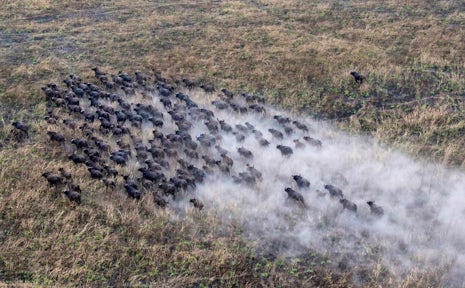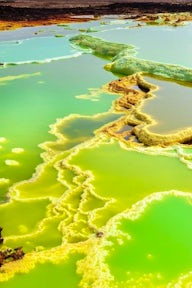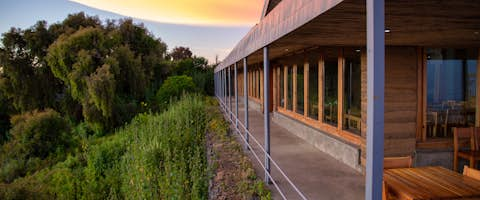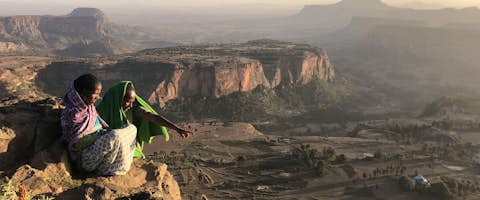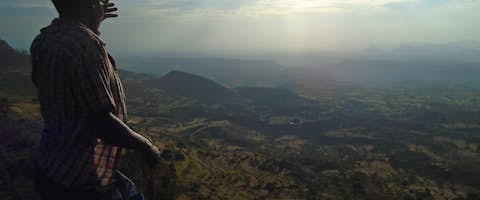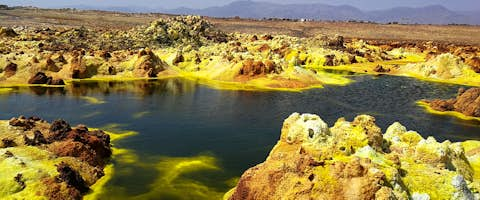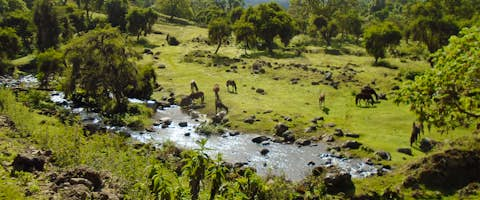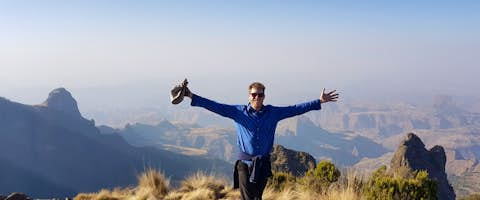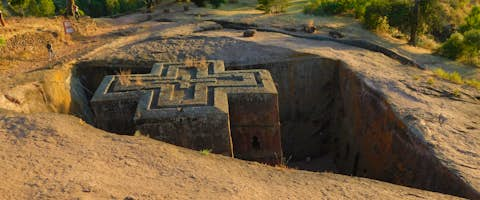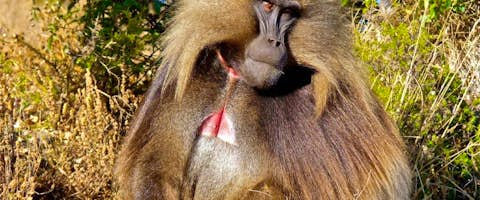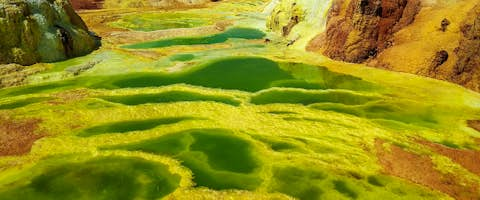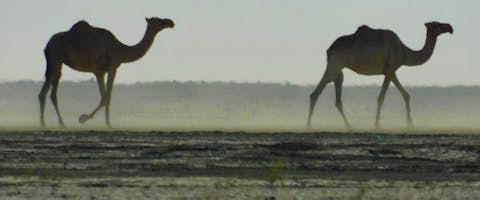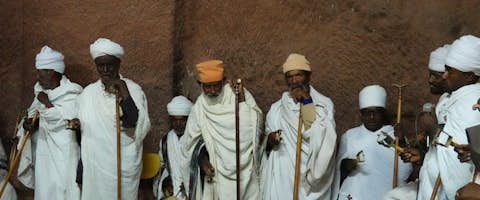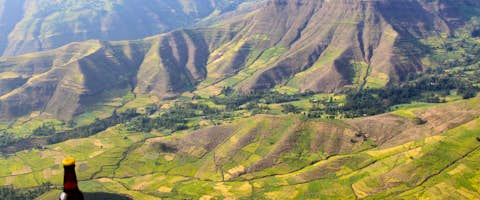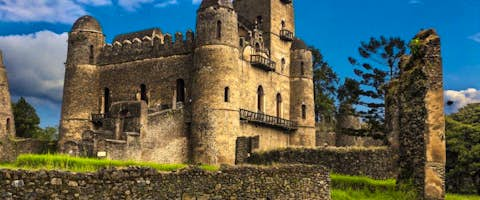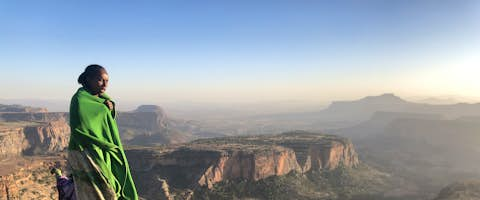Where can I camp in Ethiopia?
1. The Simien Mountains
Homer once described the Simien Mountains as the "chess pieces of the gods" and he couldn’t have been more right. These sublime mountains are an electrifying mix of precipitous ravines with looming peaks and spires. The park is full of rare, endemic wildlife, including the Ethiopian Wolf, Gelada Monkey, and Walia Ibex (giant mountain goats).
Spending your nights camping under the stars in the Simien Mountains gives you the best impression of the park, and maximise trekking opportunities. Camping allows you to see all that the park has to offer, as you trek from camp to camp. It is also the most cost-effective way to experience the park.
There are three main campsites in the Simien Mountains. Most tours start at Sankaber campsite, set on a cliff edge surrounded by Giant Heath trees (Erica Arboreal), and 360 degree panoramic viewpoints. The trail up to Sankaber from Buit Ras (the vehicle drop off point at the entrance of the Simiens) is relatively easy, but there are some steeper sections, and you'll be climbing to around 3200 metres.
East of Sankaber is Geech Campsite, situated by the dramatic Geech Abyss, where vultures and other fascinating birds of prey can be seen circling. The Jinbar Falls is an iconic landmark of the Simien Mountains, and a short walk from the Geech campsite.
If you head further east still, hiking from Geech along the plateau you'll reach Imet Gogo, perhaps the most stunning vantage point in the park. From here you can head down the valley into the Jimbar River and over to Chennek Campsite, whose spectacular surroundings include many Giant Lobelia and views of Mount Bwahit behind and the peak of Innatiye in front.
2. The Bale Mountains
The Bale Mountains National Park has an amazing blend of natural landscapes, with grassy plains, forests, volcanic ridges bizarre rock formations. Such diversity in terrain brings a lot of bio-diversity, and while most visitors choose to base themselves at the Bale Mountain Lodge, those looking for a real adventure can camp in the park.
The campsites of the Bale Mountains, despite being very basic, are usually very quiet and have beautiful views. The Webb Valley Camp is near the grassy plains of the high plateau, and it is here that the endemic Ethiopian Wolves can be spotted. Other species in the area include spotted hyenas, mountain Nyala and black-maned lions, as well as an abundance of birdlife.
If you head up to Mount Waaswma, you'll be rewarded with incredible views of the surrounding mountains and plains. Continuing on to Rafu Camp, you'll find the spectacular ‘stone forest’, a collection of unique volcanic rock formations. From here there is a fairly brief hike up to Ethiopia’s second-highest mountain, Mount Tuludimtu, where you can take in an amazing vista of the entire park.
For those only spending a night or two here, there is the option to camp at Dinsho, where the Bale Mountains National Park HQ is found. It has lovely views, as well as some basic facilities, and friendly visitors in the form of warthogs and mountain Nyala.
3. Gambella National Park
Gambella arguably offers Ethiopia’s best wildlife experiences. Its remote location shields it from population pressures, and Gambella represents a true wilderness. Huge migrating herds of wildebeest and antelope are found here, along with buffalo, hippos, giraffes, elephants, lions and many more of Africa’s most famous species. Accommodation here is in exclusive tented camps.
Unfortunately, there are very few access links to Gambella, so if you want to travel here you will need to take a charter flight.
A typical safari includes two nights at the Gambella tented camp, situated in a grove of trees close to a corner of the park that adjoins the Baro river. It is an ideal location from which to explore the northern boundary of the park, where migrating animals can most easily be spotted.
After this you can move on to spend a couple of nights in fly camps in the northwest and southwest of the park, allowing you to see more of the incredible wildlife in the park's plains, rivers, and lakes. Gambella makes for a real frontier adventure to the heart of Africa’s wilderness.
4. The Danakil Depression
Formed from the continental drift of three tectonic plates, the Danakil Depression is one of Earth’s most unique and surreal environments. Famous for being one of the hottest places on the planet, it is home to lava lakes and salt lakes, active volcanoes, and acidic springs that are bursting with colour. Visiting here is perhaps the closest you’ll come to the feeling of being on another planet.
There are no facilities or infrastructure in the Danakil Depression. Once you leave Mekele, the vibrant capital of the Tigray region and the gateway to the Danakil Depression, you'll be sleeping under the stars either on thin mattresses by the edge of volcanic crater, or on makeshift wooden beds in tiny hamlets scattered across the desert.
At Erta Ale you’ll be spending a night at the makeshift ‘campsite’ by the crater rim. The following night is typically spent at Hamed Ela, it’s a basic settlement of wooden huts, with simple beds made of bamboo frames tied together with rope - it's makeshift, but it works!
The final stop on most Danakil trips is the market town called Abaala. Here, accommodation comes in the form of homestays that are basic, but at least have running water and electricity - relative luxury when compared to the accommodation of the past two nights!
5. The Omo Valley
The Omo Valley is a cultural melting pot, 88 different communities live in this small corner of Ethiopia, each with their own traditions and ways of life. The Lower Omo Valley region is a UNESCO World Heritage Site thanks to the discovery of remains dating back millions of years, and the region has a bounty of cultural heritage, with ancient and prehistoric graves, settlements and rock carvings to be found.
The Omo is also blessed with a beautiful natural landscape of lakes, forests and mountains. Nech Sar National Park has a large number of mammals, crocodiles and the Nechisar nightjar, which is possibly the rarest bird in the world.
The infrastructure in the Omo Valley is underdeveloped by comparison to the north. Most travellers will stay at simple but characterful lodges. These lodges often suffer from maintenance issues, so it's important to set your expectations accordingly when visiting this region.
While most visitors stick to the lodges, for a truly unique experience, you should consider luxury camping. There are a number of exclusive tented and fly camps in the Omo, with Lale's Camp the most prominent, and the camps permit exclusive access to some of the Omo Valley's most remote regions.
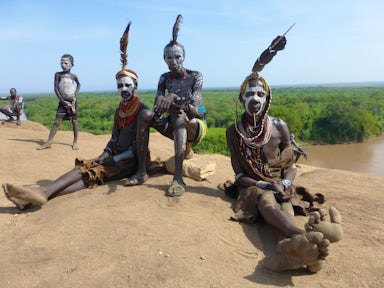
Karo Tribe in the Omo Valley.
Our Most Popular Trips
Ready to plan your Ethiopia adventure?
Listen
We'll spend some time listening to your aspirations, then discuss the kind of experience that might suit you.
Match
Next we'll discuss the options, shortlist the best trips for you and present you our impartial recommendations.
Reserve
We'll place a 24 hour hold on your preferred option - without obligation - whilst we talk through the details.
Whatever your budget, group size, length of stay, preferred activity or appetite for adventure, we can help.
+1 315 645 2889














